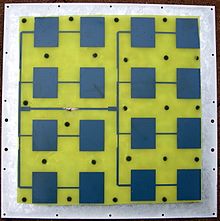Panel antenna

A panel antenna ( English flat antenna , also micro strip antenna ) is a flat antenna with directional radiation pattern, which are not - as in parabolic antennas through the focal point focusing, but by interference of the waves of individual oriented in a plane energizing elements than - array is reached (group). The focusing is achieved here by superimposing the excitation wave of each individual element.
In mobile transmission technology, it has the advantage that it can be folded down for movement, thus minimizing the area exposed to wind. For satellite TV reception it has similar advantages as the parabolic offset antenna (runoff of rainwater, less hold for ice and snow).
It is used, among other things, for W-LANs and generally for directional radio connections indoors and outdoors as well as for satellite reception.
In the 2.4 GHz ISM band , passive panel antennas achieve an antenna gain of between 12 dBi and 18 dBi. Active panel antennas with built-in antenna amplifiers reach 10 dBi to over 22 dBi, depending on their size. The beam angles are less than 8 ° to 70 °, depending on the frequency and area. The impedance is usually 50 Ω. For this purpose, the radiation elements are individually supplied in the correct phase by branched, impedance and transit time adapted strip lines. The individual elements often consist of patch antennas .
Polarization-switchable antennas of this type are also available for the reception of TV satellites . In these, the vertically or horizontally polarized emitter arrays - separated by an insulation layer and a polarization filter - lie one behind the other. These antennas are available in various sizes with a reception power that equates to standard parabolic offset antennas with a diameter of 40 cm (antenna gain approx. 32 dBi to 33 dBi) to 60 cm (according to the manufacturer, corresponds to 35 dBi to 36 dBi). They are mainly used in the non-stationary area (leisure vehicles, camping). Another use is when antennas have to remain inconspicuous (balcony). In connection with a suitable "chair frame", some designs should give the impression of a chair back at first glance.
literature
- H. Meinke, Friedrich-Wilhelm Gundlach : Pocket book of high frequency technology . Fourth edition, Springer-Verlag, Berlin 1986, ISBN 3-540-15393-4 , p. N55ff.
